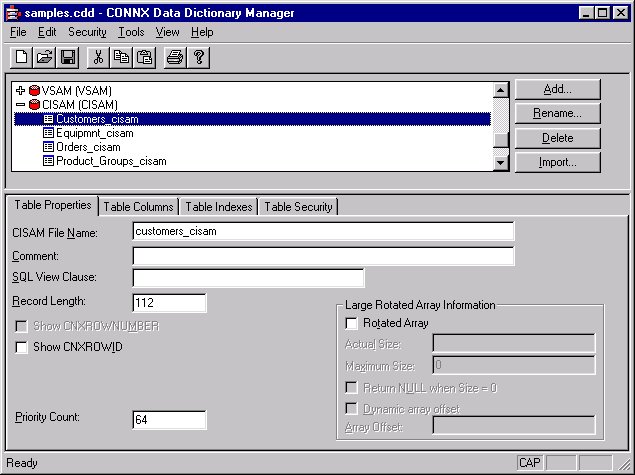Click the Add button in the CONNX Data Dictionary Manager window.

The Enter the Name of the New Table or View dialog box appears. Type the SQL Object Name.
Must be unique.
Valid CONNX table names cannot contain spaces or begin with a number.
Maximum length is 50 characters
Select Table as the type of object to create in the Object Type list box. This option determines whether the object is a view or a table definition.
Select C-ISAM, DISAM, or Micro Focus as the type of database in which to create an object in the Database list box. The option specifies the type of database in which the table is located. Valid database types for manual entry
are C-ISAM, DISAM, Micro Focus, DataFlex, and VSAM.

Click the OK button.
In the C-ISAM, DISAM, or Micro Focus File Name text box in the CONNX Data Dictionary Manager window, type the physical VMS path for the C-ISAM, DISAM, or cro Focus data
file. The maximum length of the filename is 255 characters. The C-ISAM, DISAM, or cro Focus file name may also include VAX
logicals. If a logical is used in the file name, it is important that the logical is still defined when logging onto the VMS
system as a network process.
Note: If you are running CONNX for C-ISAM, DISAM, or cro Focus within a Unix/Linux environment, enter ${<myenvironmentvariable>}
in the file path to expand an environment variable.
In the Comment text box, type up to 64 characters of descriptive text.
In the SQL View Clause text box, you may type any valid SQL expression. This text box is used to limit the type of records returned from the table. Maximum length is 128 characters. See SQL View Clause Text Box.
Record Length is automatically pulled from the data file.
The Priority Count text box displays a comparison of the relative size of the tables used in join optimization. The numbers may not match the actual number of records in the C-ISAM, DISAM, or Micro Focus file. This value is automatically pulled from the data file.